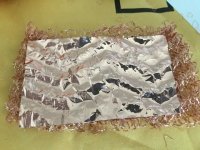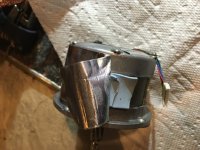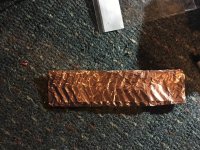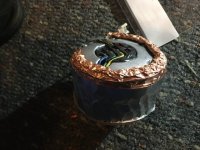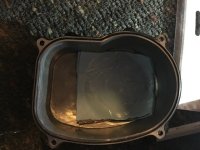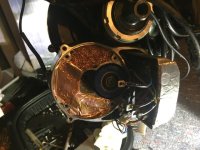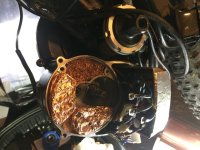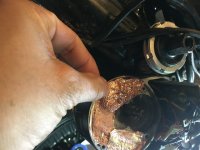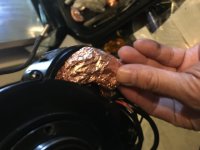You are using an out of date browser. It may not display this or other websites correctly.
You should upgrade or use an alternative browser.
You should upgrade or use an alternative browser.
Hardware temperature control tsdz2
- Thread starter andrea_104kg
- Start date
Yes, that is correct in the case of reflection/absorption.canbb said:...paint. Silver to reflect heat away and black to absorb heat. .....
IMHO better is heat transport by direct contact of different parts, what can be done by closing the airgaps with metal, grease, pads or other heat conductive material. This to prevent the heat transport from going too slowly, because of the very low air conductivity of 0,02 W/m.k
The remaining air gap between motor and outer case, could help a bit if you paint the inner case black.
Again a solution with cooling fins.
This time by Owskov
" I have had my Tsdz2 (48v.) for some months now, I run the v.19 firmware, with temp. sensor.
T58 chainring, and commute with a average speed around 35-37 km/h.
My motor gets really hot, 60-65 deg. Celsius.
I have set the temp. limits to 60-70 deg. And for sure it would get much warmer without the temp control.
while the motor is around 65 deg., I can pull 380-400W.
My conclusion is, that:
with my pattern of use, combined with the danish weather (8-15 deg. at the moment) I can pull roughly 400W. continuously. "
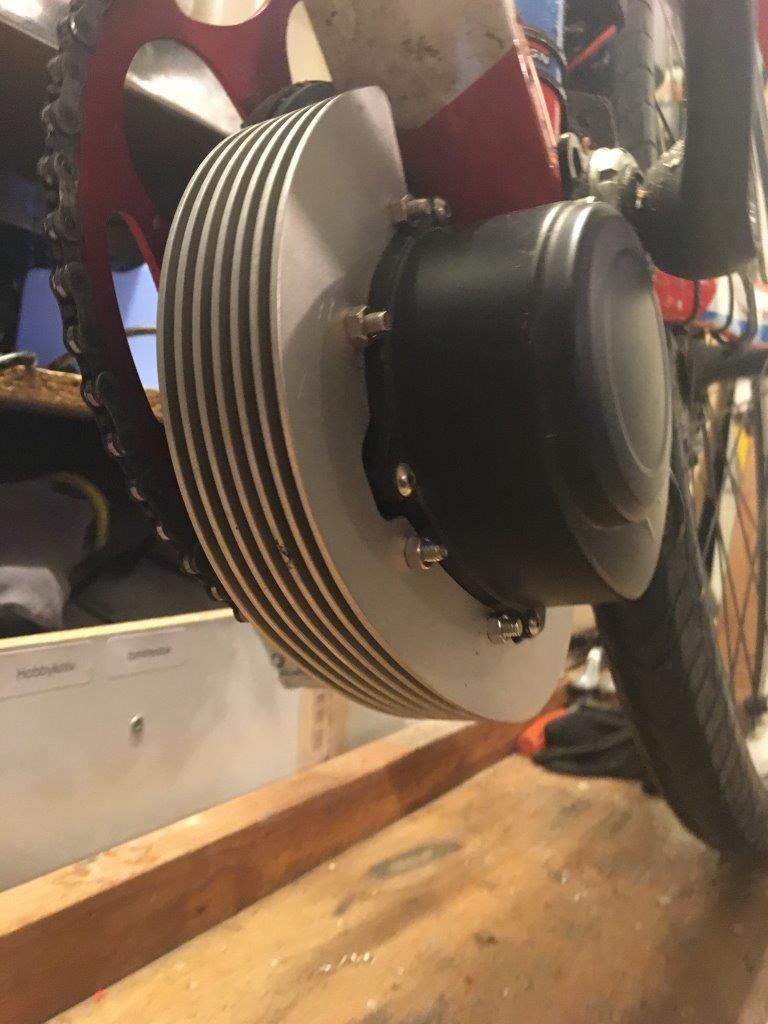
This time by Owskov
" I have had my Tsdz2 (48v.) for some months now, I run the v.19 firmware, with temp. sensor.
T58 chainring, and commute with a average speed around 35-37 km/h.
My motor gets really hot, 60-65 deg. Celsius.
I have set the temp. limits to 60-70 deg. And for sure it would get much warmer without the temp control.
while the motor is around 65 deg., I can pull 380-400W.
My conclusion is, that:
with my pattern of use, combined with the danish weather (8-15 deg. at the moment) I can pull roughly 400W. continuously. "
More and more different solutions are being offered to improve the heat dissipation of the tsdz2.
RicMcK has packed the laminated core of the motor with aluminum, combined with high-quality thermal pads and compound for better contact.
RickMcK indicates that the temperature is now almost the same both inside and outside the casing.
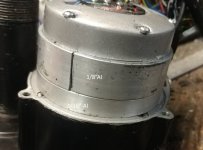
RicMcK has packed the laminated core of the motor with aluminum, combined with high-quality thermal pads and compound for better contact.
RickMcK indicates that the temperature is now almost the same both inside and outside the casing.

A small "no-cost" solution was offered by najbyk. I was forgotten to add it to this topic, but I think every small contribution to prevent overheating of the TDSZ2 is worth mentioning.
Najbyk advice is to keep the cadence of the motor as high as possible, so the energy is used more efficiently and less heat will be generated.
Najbyk advice is to keep the cadence of the motor as high as possible, so the energy is used more efficiently and less heat will be generated.
Wpenner has drastically packed his motor with conductive pads. We must have a bit patience for his experiences.
update:
"Yes, they are definitely doing something as my bike is no longer reducing power at the end of my commute. I used 2 pads. You might want to order 3 in case you mess up cutting them to shape." https://www.ebay.ca/itm/100mmx100mmx2mm-Silicone-Pad-Heat-Sink-Heatsink-Thermal-Conductive-Cooling-f/264310728713?hash=item3d8a25a809:g vUAAOSw2KlczvhZ
vUAAOSw2KlczvhZ
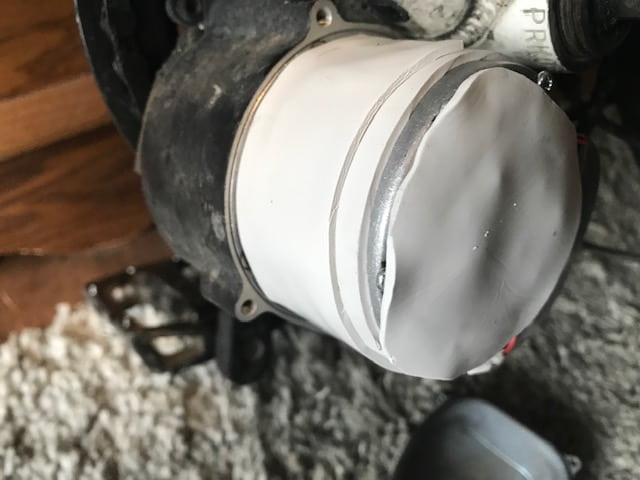
update:
"Yes, they are definitely doing something as my bike is no longer reducing power at the end of my commute. I used 2 pads. You might want to order 3 in case you mess up cutting them to shape." https://www.ebay.ca/itm/100mmx100mmx2mm-Silicone-Pad-Heat-Sink-Heatsink-Thermal-Conductive-Cooling-f/264310728713?hash=item3d8a25a809:g
Maybe nice for some people.
Was searching in old posts, I saw also an idea for improving heat conductivity mentioned by hefest
A lot of layers of aluminium foil until it fits snug.
The original source I found on German Pedelecforum. Guiri claims a better heat dissipation.

Was searching in old posts, I saw also an idea for improving heat conductivity mentioned by hefest
A lot of layers of aluminium foil until it fits snug.
The original source I found on German Pedelecforum. Guiri claims a better heat dissipation.
Because this topic is dedicated to "hardware temperature control" of the tsdz2.
I saw an interesting hardware solution if you want to use the stock firmware in combination with a temperature sensor.
sp1n4d0 came with the idea to use a temperature controller with a relay that can act as a thermostate.
If the temperature is become too high. the relay can switched the motor off/on, like the brake sensor does too.
These controllers you can buy on Ebay or AliExpress for reasonable prices and you can have a temperature display too.
I saw an interesting hardware solution if you want to use the stock firmware in combination with a temperature sensor.
sp1n4d0 came with the idea to use a temperature controller with a relay that can act as a thermostate.
If the temperature is become too high. the relay can switched the motor off/on, like the brake sensor does too.
These controllers you can buy on Ebay or AliExpress for reasonable prices and you can have a temperature display too.
Theoretically, the surface of the foil doesn't look smooth enough to eliminate any possible small air gaps.Elinx said:Maybe nice for some people.
Was searching in old posts, I saw also an idea for improving heatconductivity mentioned by hefest
A lot of layers of aluminium foil until it fits snug.
The original source I found on German Pedelecforum. Guiri claims a better heat dissipation.

I think the publisher "Guiri" had his doubts too.sysrq said:........
Theoretically, the surface of the foil doesn't look smooth enough to eliminate any possible small air gaps.
If I understand it right he claims it was an easy trial with a positive result for better heat dissipation and asked for better materials to improve this first trial. A few replies after his post there are some posts that mention thermal grease and thermal pads, but I saw never an update.
To add to the thread.
I've used cheap https://a.aliexpress.com/B4yZapte China thermal pads stacked around the stator. Since the pads are more a like clay or dough, I've used some force to get the motor cover on. Unfortunatelly I don't have any photos nor measurements.
I've used cheap https://a.aliexpress.com/B4yZapte China thermal pads stacked around the stator. Since the pads are more a like clay or dough, I've used some force to get the motor cover on. Unfortunatelly I don't have any photos nor measurements.
Thanks for the input.hefest said:.....
I've used cheap ... China thermal pads stacked around the stator. ..... I've used some force to get the motor cover on....
The thermal conductivity should be 100x better as the air-gap.
So if the pads conduct the heat, you will could feel a warm casing.
I see these pads have a 5mm thickness.
Because of the force you have used, aren't you afraid that these sticky pads give a problem if you want the cover off again?
This solution is the most quick, easy and cheap I was thinking to do same at first too without removing the motor, but was thinking to use 50mm aluminium tape between pad and case for more easy disassembly of the cover.
Elinx said:Thanks for the input.hefest said:.....
I've used cheap ... China thermal pads stacked around the stator. ..... I've used some force to get the motor cover on....
The thermal conductivity should be 100x better as the air-gap.
So if the pads conduct the heat, you will could feel a warm casing.
I see these pads have a 5mm thickness.
Because of the force you have used, aren't you afraid that these sticky pads give a problem if you want the cover off again?
This solution is the most quick, easy and cheap I was thinking to do same at first too without removing the motor, but was thinking to use 50mm aluminium tape between pad and case for more easy disassembly of the cover.
Pads come with the covering foil on both sides. I removed the foil only from the side that goes to the motor.
Your idea of the aluminum sheets over pads sounds good. Let us know how it went.
How about thermal conductive sponges?
Either metal foam or silicon?
I assume silicon foam is a lot of poorer conductor that silicon pad, but likely would be easier to put in and stay put.
Is metal foam an option?
How about some kind of paste?
I know standard silicon paste is meant to get temperature to move from one surface to another and not to work as conductor. Is there anything that would.
Ferrofluid cannot be used here, I assume ?
The motor compartment is not sealed/cannot be easilly sealed enough to put ATF in there?
Either metal foam or silicon?
I assume silicon foam is a lot of poorer conductor that silicon pad, but likely would be easier to put in and stay put.
Is metal foam an option?
How about some kind of paste?
I know standard silicon paste is meant to get temperature to move from one surface to another and not to work as conductor. Is there anything that would.
Ferrofluid cannot be used here, I assume ?
The motor compartment is not sealed/cannot be easilly sealed enough to put ATF in there?
There were already some brain sessions in the tsdz2 topic.jkekoni said:.. thermal conductive sponges?
.. metal foam or silicon?
... some kind of paste?
....Ferrofluid cannot be used here, I assume ?
If you fill the airgaps between motor and casing, any material specific for heat conductivity is problably better than just air (0,02W/m.k),
There are several choices you can make. simplicity, price, serviceable of the motor.
The use of heat conductive siliconpads is imho the most easy to put on.
The conductivity is between 1 - 13 W/m.k (from cheap to expensive). The higher value the better, but ofcourse never as good as copper or aluminium.
There was also an idea to use heat conductive silicon paste.
Ofcourse it is possible to combine materials as some practical solution demonstrate.
The solution mentioned in the wiki to fill up the flanges of the motor and is imho the most effective/cost, because with a minimum of conductive material you conducts the heat to the entire motorhousing and not only the (thin) upper case.
Eventually you can combine this too with filling the gap between stator and upper case.
silentguy
100 W
- Joined
- Sep 15, 2009
- Messages
- 162
I am going to try 99.9% copper mesh to fill the gap between the motor and case. Not sure about the cover as I don’t want to short anything, but I could tape down certain areas
I’m going to use aluminum high temp tape (600F) if I need to tape it.
My goal is just to get metal to metal contact between the motor and the motor case.
The copper mesh is only $10 on Amazon and used for rodent control.
I’m going to use aluminum high temp tape (600F) if I need to tape it.
My goal is just to get metal to metal contact between the motor and the motor case.
The copper mesh is only $10 on Amazon and used for rodent control.
Can you please give a link or picture of this copper wool?silentguy said:I am going to try 99.9% copper wool to fill the gap .....
The copper wool is only $10 on Amazon and used for rodent control.
silentguy
100 W
- Joined
- Sep 15, 2009
- Messages
- 162
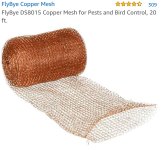 I ordered the 99.9% copper one as others are made up of alloys.
I ordered the 99.9% copper one as others are made up of alloys. They call it copper mesh.
https://www.amazon.com/gp/aw/d/B0001IMLTO?ref=ppx_pt2_mob_b_prod_image
https://www.amazon.com/Fine-Copper-Mesh-Roll-10×100cm/dp/B07Y32QTKG/ref=mp_s_a_1_31?keywords=copper+mesh&qid=1583449036&refinements=p_85%3A2470955011&rnid=2470954011&rps=1&sr=8-31#immersive-view_1583449049699
My thinking is that the thermal conductivity of copper is 385 which is about 40 times that of the thermal pads so I really only have to have 1/4 of the coverage to have the same affect ,of course there are going to be air gaps in the copper mesh but it will act as heat fins and a conductor as long as I can get good contact from the motor metal casing to the motor metal cover
One idea is to use high temperature aluminum tape to secure the copper mesh to the motor housing , as it may increase the surface contact area for conduction.
It’s the contact at the motor cover that’s going to rely on friction , and thermal grease.
I will pack the mesh densely, but make sure it’s springy enough to make good contact with the motor cover and use thermal grease too to fill some air gaps
Contact Surface area is going to be the key.
Worth a try for $10.
I wasn’t gonna pay $100 for thermal pads.
silentguy
100 W
- Joined
- Sep 15, 2009
- Messages
- 162
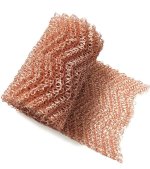 This one may be denser but it doesn’t say copper content. Even if Cu-Al alloy it’s going to be > 200 thermal conductivity.
This one may be denser but it doesn’t say copper content. Even if Cu-Al alloy it’s going to be > 200 thermal conductivity.https://www.amazon.com/Fine-Copper-Mesh-Roll-10×100cm/dp/B07Y32QTKG/ref=mp_s_a_1_31?keywords=copper+mesh&qid=1583449036&refinements=p_85%3A2470955011&rnid=2470954011&rps=1&sr=8-31#immersive-view_1583449049699
Firstly I thought too, this copper mesh could be a cheap solution, but I have some reservations for the small residual copper wires as you can see in your picture too. I think these small particles aren't a good combination with the controller and maybe the gears. As a "sandwich" this problem could be tackled a bit.
What are your thoughts about that?
Have you done a kitchen heatconductivity test already with this sandwich construction?
What are your thoughts about that?
Have you done a kitchen heatconductivity test already with this sandwich construction?
silentguy
100 W
- Joined
- Sep 15, 2009
- Messages
- 162
With the sandwich I hope to isolate the wires and avoid any wire contamination of the motor or controller. I completed sealed the mesh in several layers of copper tape.
Copper is very soft so contaminating the metal brass gears won’t have much impact but it could abrade the blue plastic gear.
We also don’t want to cause any shorts on the controller.
For the top of the motor I decided to use 1 pad of Arctic Blue thermal pad. 6 w/k conductivity as it was about 15$ for a 145mm x 145mm x1.5mm
I did not want any electrical conductivity at the top.
I was able to double up the thermal pad to make 3 mm and use this on the top of the motor and also on the top of the controller and I also use this in the middle of the motor , I protected the thermal pads with copper tape on the top of it.
I do think the copper conducts very well , much better than the thermal pad.
I also filled the air chambers on both sides of the motor case with the mesh and capped with custom shaped sandwiches.
I’ll test soon and compare the temperatures to without any copper.
I have to install the internal temp sensor today , and I also have an external temp sensor measuring outside case temp.
Copper is very soft so contaminating the metal brass gears won’t have much impact but it could abrade the blue plastic gear.
We also don’t want to cause any shorts on the controller.
For the top of the motor I decided to use 1 pad of Arctic Blue thermal pad. 6 w/k conductivity as it was about 15$ for a 145mm x 145mm x1.5mm
I did not want any electrical conductivity at the top.
I was able to double up the thermal pad to make 3 mm and use this on the top of the motor and also on the top of the controller and I also use this in the middle of the motor , I protected the thermal pads with copper tape on the top of it.
I do think the copper conducts very well , much better than the thermal pad.
I also filled the air chambers on both sides of the motor case with the mesh and capped with custom shaped sandwiches.
I’ll test soon and compare the temperatures to without any copper.
I have to install the internal temp sensor today , and I also have an external temp sensor measuring outside case temp.
That is a far-reaching addition. Filling the hollow space I see for the first time.silentguy said:.......
I also filled the air chambers on both sides of the motor case with the mesh and capped with custom shaped sandwiches......
It seems that the contact surface with the housing could not be better.
Similar threads
- Replies
- 8
- Views
- 1,253
- Replies
- 11
- Views
- 2,743
- Replies
- 112
- Views
- 24,453
- Replies
- 462
- Views
- 84,968


